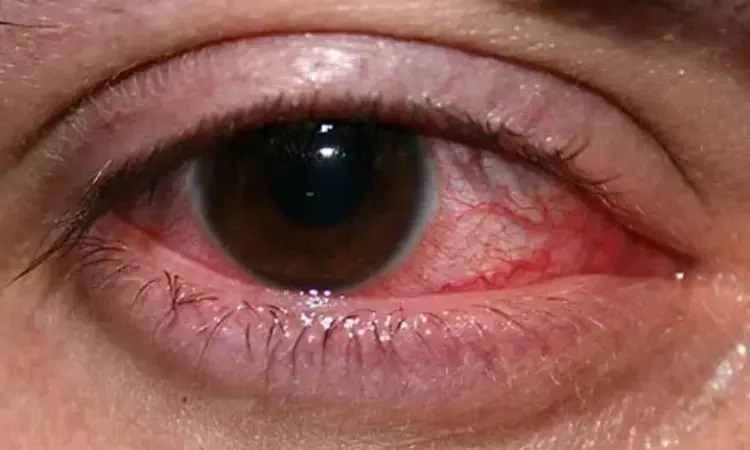- Home
- Medical news & Guidelines
- Anesthesiology
- Cardiology and CTVS
- Critical Care
- Dentistry
- Dermatology
- Diabetes and Endocrinology
- ENT
- Gastroenterology
- Medicine
- Nephrology
- Neurology
- Obstretics-Gynaecology
- Oncology
- Ophthalmology
- Orthopaedics
- Pediatrics-Neonatology
- Psychiatry
- Pulmonology
- Radiology
- Surgery
- Urology
- Laboratory Medicine
- Diet
- Nursing
- Paramedical
- Physiotherapy
- Health news
- Fact Check
- Bone Health Fact Check
- Brain Health Fact Check
- Cancer Related Fact Check
- Child Care Fact Check
- Dental and oral health fact check
- Diabetes and metabolic health fact check
- Diet and Nutrition Fact Check
- Eye and ENT Care Fact Check
- Fitness fact check
- Gut health fact check
- Heart health fact check
- Kidney health fact check
- Medical education fact check
- Men's health fact check
- Respiratory fact check
- Skin and hair care fact check
- Vaccine and Immunization fact check
- Women's health fact check
- AYUSH
- State News
- Andaman and Nicobar Islands
- Andhra Pradesh
- Arunachal Pradesh
- Assam
- Bihar
- Chandigarh
- Chattisgarh
- Dadra and Nagar Haveli
- Daman and Diu
- Delhi
- Goa
- Gujarat
- Haryana
- Himachal Pradesh
- Jammu & Kashmir
- Jharkhand
- Karnataka
- Kerala
- Ladakh
- Lakshadweep
- Madhya Pradesh
- Maharashtra
- Manipur
- Meghalaya
- Mizoram
- Nagaland
- Odisha
- Puducherry
- Punjab
- Rajasthan
- Sikkim
- Tamil Nadu
- Telangana
- Tripura
- Uttar Pradesh
- Uttrakhand
- West Bengal
- Medical Education
- Industry
Early Detection and Treatment Key in Managing Acanthamoeba Keratitis, reveals research

Researchers have found in a new study that elevated superficial punctate keratitis (SPK) is often the earliest sign of Acanthamoeba keratitis (AK) and can resemble contact lens-related sterile keratitis.
The study, published in the Journal of Optometry, analyzed 14 eyes from 13 AK patients diagnosed via detection of Acanthamoeba cysts in corneal scrapings. Corneal scraping proved to be a valuable tool for early diagnosis, enabling timely initiation of treatment and improving patient outcomes. Early recognition is particularly important because misdiagnosis or delayed intervention can worsen the disease and increase the need for surgical management.
The study showed that PHMB (polyhexamethylene biguanide) monotherapy was effective in treating early-stage AK, resulting in significant improvement in visual acuity and resolution of infection. Delayed diagnosis or prior use of steroids was associated with disease progression, including one case requiring therapeutic keratoplasty.
Patients commonly presented with SPK, dot infiltrates, radial perineuritis, pseudodendrites, stromal edema, and ring infiltrates, with SPK being the most frequent early sign. These findings highlight the importance of distinguishing AK from other contact lens-related corneal conditions to ensure rapid and appropriate treatment.
In conclusion, the study emphasizes that early detection and targeted management of AK are critical for preserving vision and preventing complications. Corneal scraping allows ophthalmologists to confirm diagnosis at an earlier stage, facilitating timely initiation of PHMB therapy and reducing the likelihood of surgical intervention.
The research underlines the need for clinicians and contact lens users to be aware of subtle early signs such as SPK. By integrating early diagnostic techniques with prompt treatment, outcomes for patients with this sight-threatening infection can be significantly improved.
Reference
Chang, W.-H., Kuo, Y.-W., & Hou, Y.-C. (2025). Optimizing early diagnosis and treatment of acanthamoeba keratitis through corneal scraping. Journal of Optometry, 100566. https://doi.org/10.1016/j.optom.2025.100566
Dr. Shravani Dali has completed her BDS from Pravara institute of medical sciences, loni. Following which she extensively worked in the healthcare sector for 2+ years. She has been actively involved in writing blogs in field of health and wellness. Currently she is pursuing her Masters of public health-health administration from Tata institute of social sciences. She can be contacted at editorial@medicaldialogues.in.
Dr Kamal Kant Kohli-MBBS, DTCD- a chest specialist with more than 30 years of practice and a flair for writing clinical articles, Dr Kamal Kant Kohli joined Medical Dialogues as a Chief Editor of Medical News. Besides writing articles, as an editor, he proofreads and verifies all the medical content published on Medical Dialogues including those coming from journals, studies,medical conferences,guidelines etc. Email: drkohli@medicaldialogues.in. Contact no. 011-43720751


